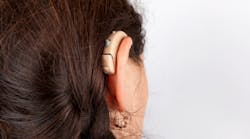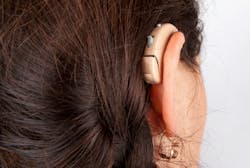Hearing-impaired patients: Are dental professionals listening?
'If a patient wishes to remove their aids, have
an office protocol. Something as simple as a
denture cup will serve the purpose.'
By Linda Rowe, RDH, MS, CDP
From my birth, I was surrounded by hearing loss. My mother lost all but a little function in one ear to severe infections. My uncle lost much of his serving in a heavy artillery unit during WWII. My grandparents suffered the typical hearing loss known as presbycusis that is associated with advancing age.
As you might suspect, this made me very aware of protecting my own hearing. I have attended very few highly amplified concerts. I wear hearing protection when using a lawnmower or snow blower. I only use ear buds for phone conversations. Nearly half of my professional dental hygiene career was spent in a periodontal practice, which limited the exposure to turbine noise.
Different conditions affect your hearing impaired patients
My path has been crossed by patients and friends with hearing loss—certainly, the older person who has the typical loss of (especially upper) range, as well as less common types of hearing loss. One patient, the mother of three teenagers, was diagnosed with otosclerosis. I became part of the story when, during her dental hygiene appointment, she commented how she "hated" the noise of the assorted instruments and procedures, but at least it wasn't so bad on the one side.
This initiated a conversation as to the history of the hearing change. Since it was not a lifelong condition, I urged her to report it to her physician. Yes, I did call her physician's office to let them know, in case she forgot to mention it. She did have surgery (stapedectomy) that included removing the stapes bone and placing a prosthetic. The significance of my mentioning her three teenagers? Otosclerosis can have a genetic component.
Another case involved a friend who also experienced unilateral hearing loss. Her diagnosis was rather alarming. The hearing loss was from an acoustic neuroma (a vestibular schwannoma), which are benign tumors located on the cranial nerves for hearing and balance. They grow slowly and may or may not require treatment.
But they can over time cause problems with: imbalance, tinnitus, weakness, or numbness of facial nerves (time to review your cranial nerve anatomy). In the course of diagnosing the neuroma, the brain scans showed a cerebral arteriovenous malformation (AVM), which was the more serious condition and required treatment to occlude the malformation, as there was a risk of a cerebral hemorrhage.
While not strictly a hearing loss, tinnitus can be associated with other hearing or medical conditions. Almost anyone who has been to a modern rock concert has probably walked out with temporary tinnitus. Tinnitus is a sound "in" the ear not generated by an external source. Often referred to as a ringing in the ear, it may be a buzzing, hissing, or low roar.
As dental practitioners, evaluating the tempromandibular joint is common practice. According to the American Hearing Research Foundation, 28% of people with TMJ experience tinnitus. My experience with it included an older patient reporting tinnitus during an appointment. She had natural dentition from tooth #20 to #28, with a full upper denture. Because she was in the habit of removing the denture at night, the dentist suggested she leave it in at night (removing it during the day for tissue rest), which kept the joint in a more natural position. This indeed was the cure for her tinnitus.
For the patient who has persistent tinnitus, a medical consult may be recommended. Medications including NSAIDS can be a cause. Vascular conditions within the ear, jugular, or carotid may be suspected if the tinnitus is more like a heartbeat in the ear. From a personal perspective, when I first became hypertensive, I experienced a high-pitched whine tinnitus.
There are several other causes for hearing loss which may be genetic or related to the processing of sound. The National Institutes of Health (NIH) website gives an overview of these causes.1
Communicating with the hearing impaired
My lifelong exposure to hearing loss lead to techniques to facilitate communications within our family, many of which apply to situations communicating with a person with hearing loss. Greet every patient face to face, with a smile. During your preliminary conversations and review of health history hearing problems may become evident. If you perceive the patient is not hearing or understanding you, apologize. Have a stock reply you are comfortable using, and it is okay to add a little humor. "I am so sorry, my mother always told me not to mumble, or to speak clearly, or to slow down." And, smile. Then slow down, speak clearly, and face the person you speaking to.
My grandfather told me it was easier to hear my voice than my mother's because it was "lower." My voice is in the alto range, but I can take it to tenor. For a person with hearing loss, an airy soprano voice can be lost in the background noise of a dental office. Learning to modulate your voice for those occasions will help. This strategy can also work well on the phone. We had one patient who could not hear the receptionist's voice, so I was tasked with making those calls back, as she could understand me on the phone.
If you see an over-the-ear hearing aid, understand that people who wear this type may choose to remove them during treatment, as my mother did. Sometimes it is to protect the device from perceived potential for damage, but often because it will mainly amplify the sounds of the dental equipment. Generally, these devices are not directional in the sounds they amplify. Because of that, if you are seated on the opposite side your voice may not be heard. Patients may also remove devices that are worn in the ear canal.
The average cost of professional hearing aids averages $4,700 for a pair,2 an expense not covered by Medicare. Technology has improved the function and decreased the size of hearing aids, allowing the devices to be small enough to be concealed within the ear canal. They may be linked to a smart phone and even the sound system of a television.
With miniaturization comes an increased risk of losing one or both of the devices. A friend's grandson recently found one of grandpa's high-tech aids on a foyer floor when it fell out of a jacket pocket. This is a common story. People will remove the aids and if not properly stored, they can easily go astray. Plan ahead. If a patient wishes to remove their aids, have an office protocol. Something as simple as a denture cup will serve the purpose.
Touch cues may work in dental office
When working with a person with hearing loss, I use a series of touch cues that I explain to patients before the amplification devices are removed. For example, a gentle tap on the chin, they can close and rest; a light finger to one side of the mouth, please turn the direction of the pressure. Of course, make sure the patient has a signal to let you know to pause treatment.
Ménière's disease is an inner ear problem that does not always result in hearing loss, but yet has the potential for altering the delivery of dental/dental hygiene care. In the cases I have known, the primary symptoms were dizziness. Depending on the severity at the time of a dental visit, it could mean very slowly adjusting the chair position or having the patient seat themselves on a pre-positioned chair. While the dizziness is certainly annoying, it can also be life-changing. One gentlemen I knew was grounded as a pilot due to the severity of the dizziness.
Dental Hygienists spend extended time with patients. Take advantage of this time to really listen not only to their words, but the meaning of what is said. You may hear clues that indicate the need for medical intervention. We are always looking at the oral systemic connection. Take tidbits of information patients "just mention" and integrate them with clinical observations. Be an advocate for interventions outside dental hygiene.
Whether the patient in your chair is aware of it or not, you will be working with hearing loss during your work day. For individuals 12 years and older in the United States, nearly 1 in 8 has bilateral hearing loss, and nearly 1 in 5 has a unilateral or bilateral hearing loss. These are the first national estimates of hearing loss in the US population based on audiometric data and a large, representative sample. While the overall risk of hearing loss may be decreasing over time,3 the prevalence of hearing loss is expected to rise because of the aging of the population.
Hearing loss is at the very least inconvenient and is associated with loss of social interaction/social isolation. As noted in the University of Ca, Berkeley School of Public Health Jan 2018 issue of Health after 50, hearing loss has also been included as a risk factor for dementia.
Be concerned about protecting your own valuable hearing. The NIH funded the development of a 10- minute test, the National Hearing Test (NHT). It must be done using a landline, and it only costs $5 (free for AARP members). The NHT results are well correlated with the gold standard based on a study conducted at VA centers. The gold standard test is pure-tone audiometry, which must be professionally administered. There are other free online tests you can do for a rough idea of your hearing status, many sponsored by device manufacturers.
Dental professionals know there are many substitutes for natural tooth surfaces or a complete tooth, but they are rarely considered equal. Protect your own hearing and be aware of changes that may be occurring in your patients' hearing. While there are an expanding numbers of ways to cope with hearing loss, just like tooth loss, none compare to the original.
For more information on protecting your hearing at work, review Anne Nugent Guignon's article Can you hear me now?4 In the June 17, 2016 issue of RDH magazine and Judy Bendit'sPersonal protective equipment you need to hear about5in the January 23, 2018 issue.
Linda Rowe, BSDH, MS, CDP, has been a registered dental hygienist for more than 37 years. As a Certified Dementia Practitioner and Independent Oral Care Specialist with Hylife Oral Health Alliance, she provides oral care to dependent adults in assisted living communities or private homes. She is also an Independent Professional Educator for Waterpik.In 2011 she was recognized with the Distinguished Service Award by the Iowa Dental Hygienists' Association.
References
- https://www.nidcd.nih.gov/health/hearing-ear-infections-deafness
- JAMA, July 2017, vol 318, p. 89
- Lin FR, Niparko JK, Ferrucci L. Hearing loss prevalence in the United States. [Letter] Arch Intern Med. 2011 Nov 14; 171(20): 1851-1852.
- http://www.rdhmag.com/articles/print/volume-36/issue-6/contents/can-you-me-now.html
- http://www.dentistryiq.com/articles/2018/01/new-personal-protective-equipment-you-need-to-hear-about.html

